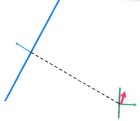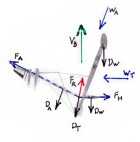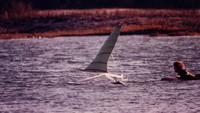High-Speed Sailing
| Vessel Name: | Sailien |
| Vessel Make/Model: | Experimental/custom |
28 September 2013
The America’s Cup
I watched, with interest, the videos of the 34th America’s Cup. At last we have fast sailboats engaged in a competition that is fun to watch. The virtual images (such as course boundaries, distance grid lines, separation between boats, etc.) overlaid on the real images really helps to keep the race [...]
31 August 2013
100 Knots for Hydroptere?
The latest news from Hydroptere is that they have plans for a 100 knot sailboat. This was posted on 26 Aug 2013, so look for that date at this address. http://hydroptere.com/en/the-news/last-news/
17 November 2012
Aptly named Sailrocket, blasts off!
While yet to be ratified, Sailrocket posted an average speed over 500 meters of 59 knots. I will not be surprised if they increase their record into the 60 knot range during this record attempt.
02 January 2012
More drag for VSR2?
I want to start by pointing out that the whole VSR2 team has done a stellar job and has demonstrated conclusively that the forces that drive a sailboat can be aligned for roll stability without using ballast and without using any down-force. (Trifoiler achieved roll stability by using down-force, but [...]
18 December 2011
My analysis of Sailrocket
I copied a diagram of VSR2 (wing doesn’t show well) and added in the major force arrows that apply. Be aware that these arrows are not correct in terms of scale (length) and some of their locations are guesses, however I believe I’m correct enough for us to learn something about what VSR2 has been [...]
23 October 2011
60 is within reach, what’s next?
I have been watching Sailrocket’s progress with great interest and there’s no question they have a winner. I fully expect to see them reach 60kt in the near future. Sailrocket has now demonstrated what I first learned with my models and again with my full-sized prototypes, that if you get the forces [...]
60 knots is easy! Is 70 possible?
I have been looking over the high-speed sailing we have been watching for the past year, sorting out various strengths and weaknesses in the contenders, and I have concluded that 60 knots should not be too difficult to achieve. Now I'm sure some will laugh and say "Sure Bob, you're just sitting there at your computer blowing hot air. Show us the record!" They are absolutely right, but there's no way I'm going to do this without some help. So this is a challenge to any of you that think you are "wild and crazy" enough to join me in putting together a real contender.
Here is my "take" on a speed record assault. I think 60 knots is "easy". Note that my idea of easy means that I think it is possible but that it will take some serious hard work and real determination. When things look like they might not be possible, I consider that to be a "difficult" project. I figure the best plan is to aim for 70 knots, 60 is a waypoint.
Why do I consider 60 "easy"? Well Hydroptere claims they hit a peak of 61 knots just before flipping; did they really? Or was that just the reading the GPS got as it was "sling-shotted" over in the flip? We don't know (maybe they don't either) but let's assume they did hit 61 before flipping. If 61 was real, then we know that cavitation is not a limiting factor for the foils they are using, up to that speed. Hydroptere is "giving away" a lot of efficiency with their set-up and they are the fastest in spite of it. For instance, when they fly the windward foil, they are not at an ideal attitude for best speed. They carry added weight in the form of ballast to keep from flipping. They have to de-power in a gust to keep from flipping. They are not very "clean" aerodynamically (think Greenbird for an example of clean aero). This is not a criticism of Hydroptere; they are the best at present. This is just to point out where to find more speed. The most important area is the one I've been saying all along; get the forces properly aligned, eliminate any ballast and any need to de-power to maintain control.
Any of you up for a real challenge?
Bob
About & Links
- Bob's Surfing Blog
- Bob's Website
- Greenbird (Windjet)
- l'Hydroptere
- Le Projet Dared
- Macquarie Speed Sailing Team
- Monofoil Sailing
- Mountain Goat STOL
- Mr Smith's Amazing Sailboats
- Patent Office (Search)
- Radboat
- Sailien Prototypes (early), Delta, etc.
- Sailien Video
- Sailien Website
- The Basics of Surfboard Design
- The Basics of Surfboard Design en Espanol
- The Swedish Speed-Sailing Challenge
- Trifoiler
- Vestas Sailrocket
- Windjet Project
- WSSRC


